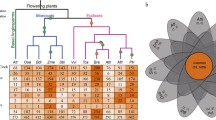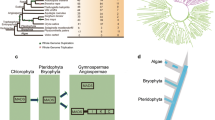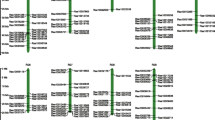Abstract
FLOWERING LOCUS T (FT), a major effect gene, regulates flowering time in Arabidopsis. We analyzed evolutionary changes distinguishing two FT homeologous loci in B. rapa, described genetic variation in homologs isolated and reported expression pattern of FT in B. juncea. Synteny analysis confirmed presence of two FT genomic copies in B. rapa ssp. pekinensis and resolved pre-existing anomalies regarding copy number in “AA” genome. Synteny analysis of B. rapa homeologous regions CR1 (129 kb) and CR2 (232 kb) revealed differential gene fractionation and wide-spread re-arrangements. Seven genomic DNA (gDNA) variants (2.1–2.2 kb) and 10 complementary DNA (cDNA) variants (528 bp) were isolated from 6 Brassica species. The gDNA variants shared 72–99 % similarity within Brassica and 58–60 % between Arabidopsis and Brassica. FT cDNA variants shared 92–100 % similarity within Brassica and 87 % between Arabidopsis and Brassica. Phylogenetic analysis of FT gDNA, cDNA and protein sequences revealed two major clades, differentiating homologs derived from species containing shared “BB” and “CC” genomes. Phylogram based on Brassica FT gDNA differentiated homeologs derived from AA-LF (Least fractioned) and AA-MF1 (Moderately fractioned) sub-genomes. Analysis of FT expression pattern in B. juncea revealed increasing levels correlating with attainment of physiological maturity; highest levels were detected in older leaves implying conservation in spatio-temporal expression pattern vis-à-vis Arabidopsis. In conclusion, our study reveals that polyploidy in Brassicas resulted in expansion of FT gene copies with homologs charting independent evolutionary course through accumulation of mutations. However, expression domains of FT remained conserved across Brassicaceae to preserve the critical function of FT in controlling flowering time.



Similar content being viewed by others
Abbreviations
- AtFT:
-
Arabidopsis thaliana FT
- BAC:
-
Bacterial Artificial Chromosome
- BRAD:
-
Brassica database
References
Ahn JH, Miller D, Winter VJ, Banfield MJ, Lee JH (2006) A divergent external loop confers antagonistic activity on floral regulators FT and TFL1. EMBO J 25:605–614
Altschul SF, Gish W, Miller W, Myers EW, Lipman DJ (1990) Basic local alignment search tool. J Mol Biol 215:403–410
Bray N, Dubchak I, Pachter L (2003) AVID: a global alignment program. Genome Res 13:97–102
Chab D, Jan Kolar J, Olson MS, Storchova H (2008) Two FLOWERING LOCUS T (FT) homologs in Chenopodium rubrum differ in expression patterns. Planta 228:929–940
Cheng F, Liu S, Wu J, Fang L, Sun S, Liu B, Li P, Hua W, Wang X (2011) BRAD, the genetics and genomics database for Brassica plants. BMC Plant Biol 11:136
Cheng F, Wu J, Fang L, Sun S, Liu B, Lin K (2012) Biased gene fractionation and dominant gene expression among the subgenomes of Brassica rapa. PLoS ONE 7(5):e36442
Doyle JJ, Doyle JL (1990) Isolation of plant DNA from fresh tissues. Focus 12:13–15
Faure S, Higgins J, Turner A, Laurie DA (2007) The FLOWERING LOCUS T-like gene family in barley (Hordeum vulgare). Genetics 176:599–609
Frazer KA, Pachter L, Poliakov A, Rubin EM, Dubchak I (2004) VISTA: computational tools for comparative genomics. Nucleic Acids Res 32:273–279
Hall TA (1999) BioEdit: a user-friendly biological sequence alignment editor and analysis program for Windows 95/98/NT. Nucleic Acids Symp Ser 41:95–98
Hannapel DJ (2013) A perspective on photoperiodic phloem-mobile signals that control development. Front Plant Sci 4:295
Hanzawa Y, Money T, Bradley D (2005) A single amino acid converts a repressor to an activator of flowering. Proc Natl Acad Sci U S A 102:7748–7753
Helliwell CA, Wood CC, Robertson M, Peacock WJ, Dennis ES (2006) The Arabidopsis FLC protein interacts directly in vivo with SOC1 and FT chromatin and is part of a high-molecular weight protein complex. Plant J 46:183–192
Kardailsky I, Shukla VK, Ahn JH, Dagenais N, Christensen SK, Nguyen JT, Chory J, Harrison MJ, Weigel D (1999) Activation tagging of the floral inducer FT. Science 286:1962–1965
Larkin MA, Blackshields G, Brown NP, Chenna R, McGettigan PA, McWilliam H, Valentin F, Wallace IM, Wilm A, Lopez R, Thompson JD, Gibson TJ, Higgins DG (2007) Clustal W and Clustal X version 2.0. Bioinformatics 23:2947–2948
Lemey P, Rambaut A, Drummond AJ, Suchard MA (2009) Bayesian phylogeography finds its roots. PLoS Comput Biol 5(9):1059–1068
Librado P, Rozas J (2009) DnaSP v5: a software for comprehensive analysis of DNA polymorphism data. Bioinformatics 25:1451–1452
Liu S, Liu Y, Yang X, Tong C, Edwards D, Parkin I, Zhao M, Ma J, Yu J, Huang S, Wang X, Wang J, Lu K, Fang Z, Bancroft I (2014) The Brassica oleracea genome reveals the asymmetrical evolution of polyploid genomes. Nat Commun 5:3930
Livak KJ, Schmittgen TD (2001) Analysis of relative gene expression data using real-time quantitative PCR and the 2-ΔΔcT method. Methods 25:402–408
Mimida N, Goto K, Kobayashi Y, Araki T, Ahn JH (2001) Functional divergence of the TFL1-like gene family in Arabidopsis revealed by characterization of a novel homologue. Genes Cells 6:327–336
Navabi ZK, Huebert T, Sharpe AG, O’Neill CM, Bancroft I, Parkin IA (2013) Conserved microstructure of the Brassica B Genome of Brassica nigra in relation to homologous regions of Arabidopsis thaliana, B. rapa and B. oleracea. BMC Genomics 14(1):250
Sankoff D, Zheng C, Zhu Q (2010) The collapse of gene complement following whole genome duplication. BMC Genomics 11(1):313
Schmid M, Davison TS, Henz SR, Pape UJ, Demar M, Vingron M, Schölkopf B, Weigel D, Lohmann JU (2005) A gene expression map of Arabidopsis thaliana development. Nat Genet 37:501–506
Shivaraj SM, Dhakate P, Mayee P, Singh A (2014) Natural genetic variation in MIR172 isolated from Brassicas. Biol Plant 58(4):627–640
Sparks E, Wachsman G, Benfey PN (2013) Spatiotemporal signalling in pant development. Nat Rev Genet 14:631–644
Sri T, Mayee P, Singh A (2015) Sequence and expression variation in SUPPRESSOR OF OVEREXPRESSION OF CONSTANS 1 (SOC1): homeolog evolution in Indian Brassicas. Dev Genes Evol 225(5):287–303
Tamura K, Stecher G, Peterson D, Filipski A, Kumar S (2013) MEGA6: molecular evolutionary genetics analysis version 6.0. Mol Biol Evol 30:2725–2729
Wang J, Long Y, Wu B, Liu J, Jiang C, Shi L, Zhao J, King GJ, Meng J (2009) The evolution of Brassica napus FLOWERING LOCUS T paralogues in the context of inverted chromosomal duplication blocks. BMC Evol Biol 9:271
Wang X, Wang H, Wang J, Sun R, Wu J, Liu S, Bai Y, Mun J-H, Bancroft I, Cheng F, Huang S, Li X, Hua W, Wang J, Wang X, Freeling M, Pires JC, Paterson A, Chalhoub B, Wang B, Hayward A, Sharpe A et al (2011) The genome of the mesopolyploid crop species Brassica rapa. Nat Genet 43(10):1035–1039
Wickland DP, Hanzawa Y (2015) The FLOWERING LOCUS T/TERMINAL FLOWER 1gene family: functional evolution and molecular mechanisms. Mol Plant 8(7):983–997
Yamaguchi A, Kobayashi Y, Goto K, Abe M, Araki T (2005) TWIN SISTER OF FT (TSF) acts as a floral pathway integrator redundantly with FT. Plant Cell Physiol 46:1175–1189
Yoo SY, Kardailsky I, Lee JS, Weigel D, Ahn JH (2004) Acceleration of flowering by over expression of MFT (MOTHER OF FT AND TFL1). Mol Cells 17:95–101
Ziolkowski PA, Kaczmarek M, Babula D, Sadowski J (2006) Genome evolution in Arabidopsis/Brassica: conservation and divergence of ancient rearranged segments and their breakpoints. Plant J 47(1):63–74
Acknowledgments
The authors thank Dr. Arvind Kumar, DDG (Education, ICAR), Dr J.S. Chauhan, ADG (Seed, ICAR) and Dr. Abha Agnihotri (Amity University, Noida) for providing the germplasm. Dr. S.B. Tripathi and Mr M.S.Negi for offering valuable suggestions. S.M. Shivaraj, Priyanka Dhakate and Shikha Tyagi for technical assistance and motivation. Contribution of Mr. Hari Ram Gupta in field-related activities is appreciated. Financial support for this study from Department of Biotechnology, Govt. of India (BT/PR8659/PBD/16/739/2006, BT/PB/01/01/2011) is gratefully acknowledged. Infrastructural support from TERI and TERI University are also acknowledged.
Author information
Authors and Affiliations
Corresponding author
Ethics declarations
We accept all norms.
Funding
Author Anandita Singh has received research grants from Department of Biotechnology, Govt. of India (BT/PR8659/PBD/16/739/2006, BT/PB/01/01/2011).
Conflict of interest
We Pratiksha Mayee and Anandita Singh hereby declare that we have no conflict of interest.
Electronic supplementary material
Below is the link to the electronic supplementary material.
Supplementary Fig. A1
Sliding window analysis of FT gDNA sequences from Brassica species and A. thaliana. The graphical output using DNAsp 5.0 (window size = 25 bp, step = 2) shows that the sequences corresponding to exons are more conserved compared to the introns. The regions where the Pi value peaks and dips correspond to predicted introns and exons, respectively (PDF 361 kb)
Supplementary Fig. A2
Phylogram of Brassica FT gDNA sequences. The sequences are clustered in two distinct clades. The homologs isolated from B. napus, B. carinata and B. oleracea (containing shared “CC” genome) form one clade (Group I), while sequences isolated from B. nigra and B. juncea containing shared “BB” genome form a distinct clade (Group II) (PDF 122 kb)
Supplementary Fig. A3
Phylogenetic analysis of in-silico translated FT. The protein variants from Brassica display similarity with FT and TSF compared to the other family members. FT sequences from B. oleracea and B. napus belong to one clade (Group I) while B. juncea, B. rapa, B. nigra and B. carinata form a different clade (Group II) (PDF 350 kb)
Supplementary Fig. A4
Phylogenetic analysis of FT proteins from angiosperms. The sequences from genus Brassica are monophylogenetic and form a distinct clade closer to AtFT (PDF 262 kb)
ESM 1
(DOCX 29 kb)
Rights and permissions
About this article
Cite this article
Mayee, P., Singh, A. Natural genetic variation in Brassica homologs of FLOWERING LOCUS T and characterization of its expression domains. J. Plant Biochem. Biotechnol. 25, 270–277 (2016). https://doi.org/10.1007/s13562-015-0338-2
Received:
Accepted:
Published:
Issue Date:
DOI: https://doi.org/10.1007/s13562-015-0338-2




